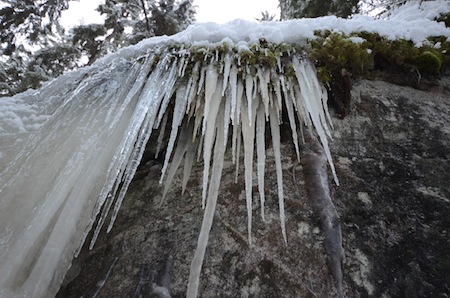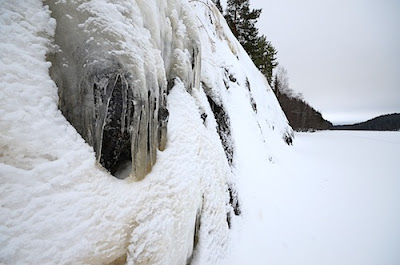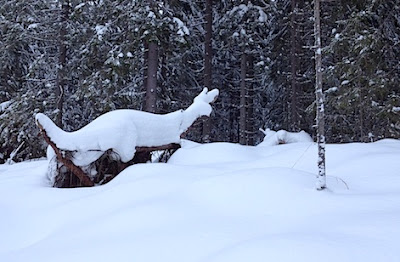Oh Aavasaksa beautiful! And thy sky so blue! Aavasaksa and the its neighbour Tornio River valley are among the 27 national attractions in Finland and the site has been famous for centuries, mostly because of Midnight Sun. The hilltop offers great views - also across the border to Sweden - so it is well worth a visit. I plan to take over the hilltop on snowshoes, but put them on only after entering the Aavasaksan kruununpuisto (Aavasaksa's Crown Park - the name dates back to the days when Finland was not yet a democracy). One of the marked routes on Aavasaksa will take me up, around the hilltop and back down to the holiday village.
I step on the pure, white snow and locate the marked Kruununkierros (Crown Tour) trail; more by the footprints of the previous walker than by the trail marks which are almost totally buried under the snow. I might even attempt to follow the trail without snowshoes but as they give me the liberty to step off the track, I prefer to wear snowshoes. Very soon I spot footprints, or hoof prints by some other creatures. And some fresh droppings. A flock of reindeer must have just passed by!
Aavasaksa hill is not very steep on this side. However, the gradual ascent soon takes me high enough to get a good view to the south although I am not even close to the hilltop. A sign by the path informs me that there were ancient trees here until Pierre Louis de Maupertuis and his expedition came to Aavasaksa in 1736-37 to conduct their measurements, having determined it a great place as a triangulation point when they were examining the shape of the Earth. To be able to see well enough to the next triangulation points, they needed an open view and thus demanded the trees to be cut down from the hilltop.
The wind has created interesting formations of snow around some pine trees which typically may grow to a funny, slightly curly shape in a place like this. However, the sun is doing its best to destroy the natural snow hut.
Aavasaksa's hilltop was never buried underwater like many of its neighbours; after the Ice Age was over and the ice started melting, the hilltop was an island in the ice-cold sea which reached 208 meters higher than the sea level is today. So...the waves were splashing against the rocks not too far from me. Down below is Tengeliö River which goes round Aavasaksa hill before it meets the great Tornio River. I walk a bit further - and over there the fantastic view opens to the north. If the sun is not hidden behind clouds at Midsummer, you simply can't miss it from this hilltop.
I look to my left and see a statue between the trees. Annikki Kariniemi (1913-84) was a Finnish author whose work focused on her native Lapland.
There are several marked trails that circle on Aavasaksa - the yellow one is called Sun Tour, the brown one Imperial Tour, the black one Crown Tour. The blue line marks a cross country skiing track. I step off the trail and climb to the top where the buildings are, among them the observation tower from where you get the best views. When I reach the tower, I hear that a flock of reindeer has indeed just passed the hill - did I see them? A close shave. Just their droppings.
After I brush away a bit of snow, the interesting looking caged rock turns out to be a memorial for Pierre Louis de Maupertuis and the expedition of L'Académie Française that came here in mid 18th century to do their measurements. The Swedish astronomer Anders Celsius - who we are to thank for the Celsius thermometer - was also part of this expedition. Based on his measurements along Tornio River, Maupertuis managed to prove that the Earth is flattened near the poles.
Maupertuis may have been the first to conduct such significant measurements atop Aavasaksa but about one hundred years later another astronomer Friedrich von Struve had the triangulation points marked permanently. Aavasaksa is part of the Struve Geodetic Arc which is on the Unesco World Heritage list, as one of the six protected such points in Finland. Struve was also measuring the shape of the earth and he came to Aavasaksa in 1845. The triangulation point is on the highest point of Aavasaksa, at 242 meters above sea level, which is right under the observation tower.
To my delight, the observation tower is open also in winter! The steps are inside the tower so you can climb up without being exposed to the wind.
From the observation tower the views are breathtaking on this sunny day which is so bright that my eyes almost hurt. Behind the Imperial Lodge the view extends across the Tornio River which marks the border between Finland and Sweden. So yes, on the other side of the river there are Swedish mountains.
Tourists and travellers have come to Aavasaksa to admire the views especially in the summer for centuries. One of the people who planned a visit to Aavasaksa as part of his trip to Ostrobothnia and Lapland, was Alexander II, Czar of Russia and Grand Duke of Finland. The Imperial Lodge was built in his honour in 1882 but unfortunately, the Czar never came here. Luckily, the building is still there and it has been restored.
The Imperial Lodge combines many different styles and different types of ornaments. The Lodge is only open in summer but this is nothing new; I am used to finding closed doors on my winter trips, especially now that the schools' winter holiday season is over.
So naturally it is not possible to shop in the Jugend style kiosk (1912) either.
I leave the hilltop and start the descent but instead of heading straight back to the marked trail, enjoy my freedom trail on the pure white snow. There is no fear of getting lost; I can focus on enjoying the sun, the view to Tornio River, the silence around me. Only occasionally do I hear a motor somewhere in the distance.
Finally, I end up back on the Crown Trail and check out the shelter - very few logs left for making a fire but I'm quite happy without it now - before heading to the holiday village where I started from.
Goodbye to all the snow-covered trees and the gorgeous views of Aavasaksa!
I step on the pure, white snow and locate the marked Kruununkierros (Crown Tour) trail; more by the footprints of the previous walker than by the trail marks which are almost totally buried under the snow. I might even attempt to follow the trail without snowshoes but as they give me the liberty to step off the track, I prefer to wear snowshoes. Very soon I spot footprints, or hoof prints by some other creatures. And some fresh droppings. A flock of reindeer must have just passed by!
Aavasaksa hill is not very steep on this side. However, the gradual ascent soon takes me high enough to get a good view to the south although I am not even close to the hilltop. A sign by the path informs me that there were ancient trees here until Pierre Louis de Maupertuis and his expedition came to Aavasaksa in 1736-37 to conduct their measurements, having determined it a great place as a triangulation point when they were examining the shape of the Earth. To be able to see well enough to the next triangulation points, they needed an open view and thus demanded the trees to be cut down from the hilltop.
The wind has created interesting formations of snow around some pine trees which typically may grow to a funny, slightly curly shape in a place like this. However, the sun is doing its best to destroy the natural snow hut.
Aavasaksa's hilltop was never buried underwater like many of its neighbours; after the Ice Age was over and the ice started melting, the hilltop was an island in the ice-cold sea which reached 208 meters higher than the sea level is today. So...the waves were splashing against the rocks not too far from me. Down below is Tengeliö River which goes round Aavasaksa hill before it meets the great Tornio River. I walk a bit further - and over there the fantastic view opens to the north. If the sun is not hidden behind clouds at Midsummer, you simply can't miss it from this hilltop.
I look to my left and see a statue between the trees. Annikki Kariniemi (1913-84) was a Finnish author whose work focused on her native Lapland.
There are several marked trails that circle on Aavasaksa - the yellow one is called Sun Tour, the brown one Imperial Tour, the black one Crown Tour. The blue line marks a cross country skiing track. I step off the trail and climb to the top where the buildings are, among them the observation tower from where you get the best views. When I reach the tower, I hear that a flock of reindeer has indeed just passed the hill - did I see them? A close shave. Just their droppings.
After I brush away a bit of snow, the interesting looking caged rock turns out to be a memorial for Pierre Louis de Maupertuis and the expedition of L'Académie Française that came here in mid 18th century to do their measurements. The Swedish astronomer Anders Celsius - who we are to thank for the Celsius thermometer - was also part of this expedition. Based on his measurements along Tornio River, Maupertuis managed to prove that the Earth is flattened near the poles.
Maupertuis may have been the first to conduct such significant measurements atop Aavasaksa but about one hundred years later another astronomer Friedrich von Struve had the triangulation points marked permanently. Aavasaksa is part of the Struve Geodetic Arc which is on the Unesco World Heritage list, as one of the six protected such points in Finland. Struve was also measuring the shape of the earth and he came to Aavasaksa in 1845. The triangulation point is on the highest point of Aavasaksa, at 242 meters above sea level, which is right under the observation tower.
To my delight, the observation tower is open also in winter! The steps are inside the tower so you can climb up without being exposed to the wind.
From the observation tower the views are breathtaking on this sunny day which is so bright that my eyes almost hurt. Behind the Imperial Lodge the view extends across the Tornio River which marks the border between Finland and Sweden. So yes, on the other side of the river there are Swedish mountains.
Tourists and travellers have come to Aavasaksa to admire the views especially in the summer for centuries. One of the people who planned a visit to Aavasaksa as part of his trip to Ostrobothnia and Lapland, was Alexander II, Czar of Russia and Grand Duke of Finland. The Imperial Lodge was built in his honour in 1882 but unfortunately, the Czar never came here. Luckily, the building is still there and it has been restored.
The Imperial Lodge combines many different styles and different types of ornaments. The Lodge is only open in summer but this is nothing new; I am used to finding closed doors on my winter trips, especially now that the schools' winter holiday season is over.
So naturally it is not possible to shop in the Jugend style kiosk (1912) either.
I leave the hilltop and start the descent but instead of heading straight back to the marked trail, enjoy my freedom trail on the pure white snow. There is no fear of getting lost; I can focus on enjoying the sun, the view to Tornio River, the silence around me. Only occasionally do I hear a motor somewhere in the distance.
Finally, I end up back on the Crown Trail and check out the shelter - very few logs left for making a fire but I'm quite happy without it now - before heading to the holiday village where I started from.
Goodbye to all the snow-covered trees and the gorgeous views of Aavasaksa!

























































